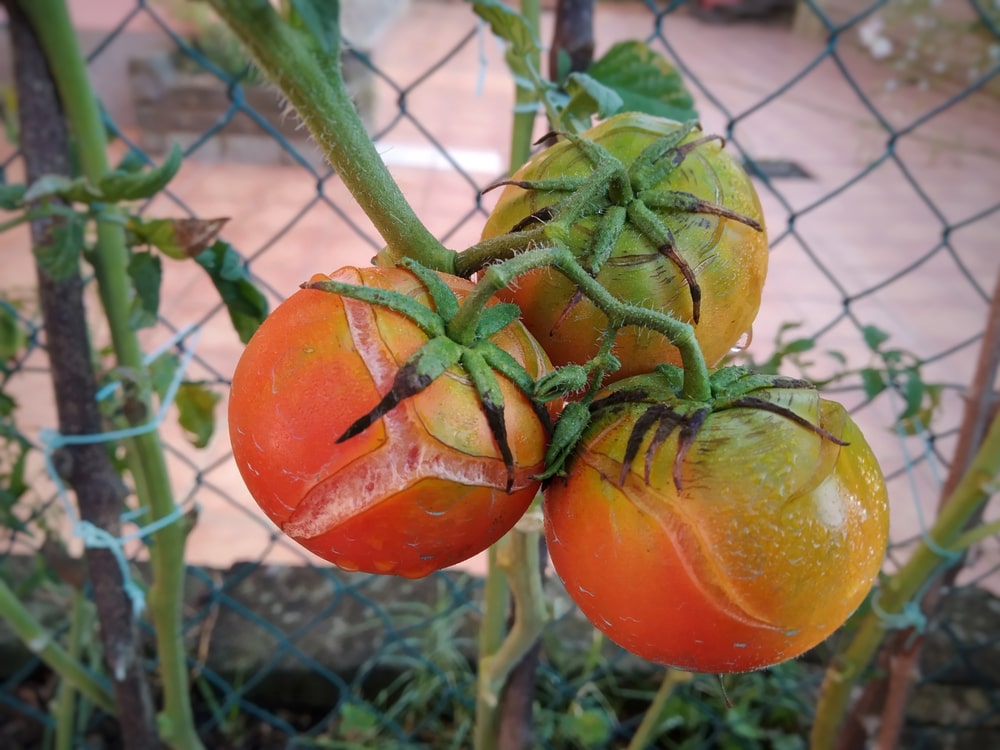Ever gone to pick a tomato and found it’s not what you expected? Well, the tomatoes are ripening, so here’s what to look for:
Tomato Problems
Blossom End Rot
These are black lesions at the bottom of the fruit. A calcium deficiency causes it—but it might not be due to a lack of calcium in the soil. Other factors that can affect the uptake of calcium may be:
- Planting too soon: If you plant when soil temperatures are below 65 degrees or so, it might affect the plant’s ability to take nutrients from the soil.
- Using a higher nitrogen fertilizer: Be sure to use a fertilizer with more phosphorus than nitrogen. Phosphorus is the middle number on your fertilizer and needs to be a little higher than the first number, nitrogen. Tomato-tone by Espoma Organic is my favorite, but if it isn’t available, use any blossom-promoting fertilizer.
- Inconsistencies in watering: Never let a tomato get so dry it begins to droop, but also be sure NOT to water if the soil is still dark and moist to the touch. Yes, I know—sometimes Mother Nature forgets to “turn the water off,” but don’t compound the problem by watering too much yourself.
- A soil pH that is too alkaline: Tomatoes prefer soil with a pH of 6.0 to 7.0.
Cat-Facing
Cat facing is a disorder that causes deformities on the bottom of the tomato—scar tissue-filled cracks, abnormal cavities, and small swollen bulges. It seems to center around environmental stresses that cause incomplete pollination. Possible causes are:
- Planting too soon, when soil temperatures are too cold.
- Excessive heat and humidity.
- Inconsistent watering.
Cracking
Cracks in the stem end of the tomato. This is usually caused by inconsistent watering. Heirloom tomatoes, particularly beefsteak types, seem more prone to cat-facing and cracking.
Not Setting Fruit
One annoying thing about tomatoes is they often stop setting fruit when daytime temperatures are over the low nineties. While tomatoes are self-pollinating, in excessive heat and humidity, the pollen can degrade so it clumps, making it challenging to self-pollinate.
Mulch around the roots with mulch-like straw to keep moisture even and keep the roots cool. Do NOT feed during excessive heat! Plants don’t want to be forced to grow under weather stress.
Fruits With Holes
This can be caused by one of two things—birds or squirrels. I’ve seen cardinals perched on the sides of tomato cages, pecking the heck out of ripe tomatoes. You can try bird netting, but I don’t like it because sometimes small critters can get caught in it. I just pick the tomato when it’s “mostly” ripe and let it finish on the windowsill. Also, provide a water source elsewhere to tempt birds to the other side of the yard.
However, if you’re finding green tomatoes with one bite missing, that is probably because squirrels are looking for moisture content. The cure is simple—spray green tomatoes with a repellent or an extract of cayenne pepper, or sprinkle cayenne pepper on the fruit. Also, provide an EASILY accessible water source 10 to 15 feet away—a birdbath or even a saucer filled with water.
It’s a matter of survival, though—if you don’t provide an easily accessible water source, they’ll go after the tomato anyway.
Need Help or Have Questions?
If you’re having a weird problem with your tomatoes, come in and let us help. If you are having ANY gardening problem, stop by and let us help you solve it. That’s why we’re here!

